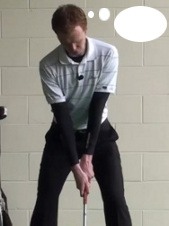
As you're preparing to hit a golf shot, what are you thinking about?
a) Your technique (“slow on the takeaway,” “full shoulder turn”).
b) The possible results of your shot (“into the water and my score is sunk,” “please don't let me top it”).
c) Nothing at all.
If you answered “c,” congratulations. Most golfers play best when they swing unconsciously. It's a very rare state, indeed.
If “b” was your pick, then your mind is distracted from the actual task. Those who said “a” are at least on the path to proper thinking.
Most professional golfers, especially those who work with mental coaches, adopt what's called a “process vs. outcome” or “process/now” approach. Amateurs, on the other hand, tend to fall into a results-oriented mindset.
What's the difference, and what does it matter?
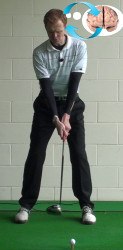
Focusing on the process means staying in the moment, taking the game one swing at a time. The golfer repeats the same sequence of steps before setting up to shot and, if necessary, calls up the same swing key(s) before taking the club back. In other words, he thinks only about those things he can control – and that excludes big-picture consequences that may affect his score. In other words, he doesn't get ahead of himself.
Results-oriented golfers do the opposite. They're distracted by the possible outcomes of a shot, causing their concentration to wander and, many times, creating jitters and tension from fear of a bad result (thus making a bad result all the more likely.)
On top of that, letting your mind drift toward possible outcomes prevents you from channeling all your mental energy into the shot at hand. You may forget a specific swing key, fail to account for the wind or choose the wrong club. It's difficult to achieve good results when that happens.
The best way to shift from results-oriented to process/now thinking is to develop and maintain a consistent, easily repeatable pre-shot routine. This will force your mind to focus on a handful of thoughts, one at a time, all related to the current shot. The key is to limit the number of thoughts in preparing for each swing; otherwise, the brain becomes cluttered and performance suffers.
Learn to think with a “process/now” mentality and you'll like the outcome a whole lot better.

What is a Process Vs Outcome Approach?
The way you think about your golf game is important. There is a huge mental component to the game, and that component extends far beyond simply deciding what club to use for each shot. In golf, you are in charge of everything – you fill every role that would be assigned to a different individual in a team sport. You are the head coach, the general manager, and the player all in one. Even if you have a swing coach who helps you with your technique, you are still in charge of the whole operation. If your game is going to get better, it will be because you make the right decisions at the right times.
In this article, we are going to dive into the mental side of how you can improve your game. Specifically, we are going to talk about having a process-based approach vs. having an outcome-based approach. These are two dramatically different ways of looking at your golf game, and they can lead to wildly different outcomes. This may not be something you have thought about previously with regard to your game, but by the end of this article we hope you will understand the importance of this topic.
This concept is based around the way you think about what happens to you on the course. Golfers react in all kinds of different ways to the shots they hit, and how you react says a lot about your game and where you are headed. By teaching yourself to react the right way, you can set your game on a path for long-term improvement. On the other hand, if you react in the wrong way, you may find yourself stuck in the same place for many years to come. Learn how to properly interpret what happens on the course and you will find it much easier to progress.
Before we get started outlining the details of a process or outcome approach, it is important to mention that you need to take your emotions out of the picture as much as possible when monitoring your game. Sure, you are going to be frustrated after a bad shot or excited after a good one, but those emotions shouldn't get in the way of making rational evaluations. When analyzing your own game to find ways in which you can approach, everything should be as objective as possible. Set your emotions aside, allow yourself to calm down, and think carefully about what has happened on the course. When you proceed this way, the conclusions you come to are far more likely to be the right ones.
All of the content below is based on a right-handed golfer. If you play golf left-handed, please take a moment to reverse the directions as necessary.
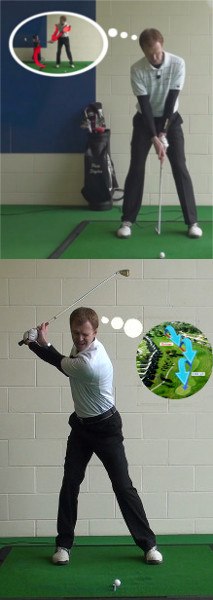
Understanding the Difference
To get started, we need to define a process-based approach vs. an outcome-based approach, and we need to look at what makes these two so different. As you are reading through this section, think about how you currently view your game and try to decide which of these two angles you take at the moment. Don't worry if you aren't thinking about your game in the ideal manner just yet – this article will hopefully help you change your approach moving forward.
- Process Approach. When you think about your game from a process perspective, you are more worried about the things you can control than anything else. For instance, you will think a lot about your swing technique, because that is something you directly control. Also, you will think about course management, as that is in your control, as is the amount of time you spend practicing your game. Basically, if you have direct control over an element of your golf game, it falls into the process category. These are the things you will think about when approaching the game from this perspective, and you will work on refining those elements to make yourself a better golfer.
- Outcome Approach. You can probably guess what this is all about simply from the name of the method. Rather than paying attention to the process you use throughout the round, you are only going to be concerned with outcomes. If you shoot a good score, for instance, you will assume that you did everything properly during the day. Or, on a smaller level, you will assume that a shot which ends up close to the hole must have been hit properly. Unfortunately, the outcome approach to self-analysis can frequently lead you astray. For instance, if you completely top a shot from the middle of the fairway, the ball is going to roll along the ground rather than rising up into the sky. Most of the time, such a shot will end up in a bad place. If, however, the ball finds its way onto the green, you could decide that you have hit a good shot (based on outcome analysis). Did you actually hit a good shot? No, of course not. You hit a poor shot, and got lucky that the ball found its way onto the putting surface. Basing your evaluation of your own game on strictly outcomes is a mistake, and it will make it difficult for you to improve your play over time.
When you read through the points above, it is pretty obvious that process-based analysis is the way to go. After all, if you stick with a good process over and over again for years to come, you are going to get the results you desire more times than not. Sure, there will be a bad shot from time to time, and you will have some bad luck along the way, but good process is usually going to lead to good results.
Despite the fact that this decision seems so obvious, you may be surprised to learn that most golfers actually use outcome-based evaluation in their games. Why? Because it's easier. You don't have to think very hard to evaluate your performance based on results. If the ball is in the fairway, or on the green, or in the cup, you have done a good job. Likewise, if you have shot a low score for the round, you must have played well. Basing your evaluations on outcomes is easy, and many golfers simply choose to take the easy way out.
If you would like to stand out from the crowd with the quality of your game, it would be wise to resist the easy way. Sure, you might have to think a little bit more carefully when you base your self-evaluation on process instead of results, but it will be worth it in the end. You will be able to make meaningful decisions about your game, and you will be able to use those decisions to drive positive change. In the end, you will be a better golfer because you were willing to look beyond the outcomes and see the underlying process for both its good and bad characteristics.
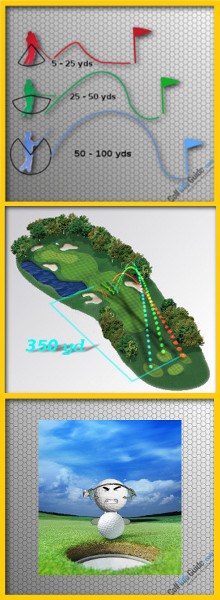
Common Outcome-Based Mistakes
At this point, you might be realizing that you currently base a lot of your golf decisions on outcomes rather than the processes that lead to those outcomes. So, how do you get away from such a pattern? The first step is to understand some of the commonly accepted outcome-based evaluations that golfers make. The list below includes a number of ways you may evaluate your own performance on the golf course if you are looking at things strictly from an outcome perspective.
- Hitting the fairway is a good drive. It is true that your goal when standing on the tee is to hit the ball into the fairway. However, does that mean that every drive which hits the fairway is a good one? Certainly not. Imagine, for instance, that you are playing a hole with an extremely wide fairway. Due to the shape of the hole, only tee shots in the left side of the fairway will have a good angle to approach the green. Although you aim for the left side of the fairway, you hit the ball down the right. The tee shot comes to rest in the short grass, but you have little chance of hitting the green with your next swing. In this case, outcome-based analysis may lead you to believe you did a good job. After all, you hit the ball into the fairway. Of course, you didn't really do your job, because you don't have much of an angle for your approach. This tee shot was a failure, and should be considered as such when you review your performance. Instead of celebrating the fairway hit, you should be looking at what went wrong to cause your ball to travel into the incorrect side of the short grass.
- Making a par is a good score. Most of the time, you will be happy to make a par on a hole. It is great to make birdies, of course, but pars are good scores, and they will keep you on track for a nice round. But what if you hit a huge drive on a short par five, and you had less than 200 yards to the green for your second shot? In that case, a par might not be such a good score. Basing your evaluation only on results, you would see a par on the card and feel good about that hole. That par doesn't tell the entire story, however. You probably should have made a birdie, or even an eagle, based on the position you were in.
- Missing the green is a bad approach shot. The first goal you have in mind when hitting an approach shot is simply to hit the putting surface. You want to leave the ball on the green so you can hopefully two putt for your par – or even one putt for your birdie. With that said, not all approach shots are going to hit the green. Even the best golfers in the world miss greens from time to time. So, is every missed green you experience on the course the result of a bad shot? Absolutely not. It is very much possible to hit a great shot and have the luck of the draw come up against you. One great example is the dreaded gust of wind. If you strike a perfect approach shot high into the air, only to have a gust of wind come up mid-flight and knock your ball down, the shot may miss the green short even though you did nothing wrong. Outcome-based evaluation would have you looking into your technique for things to correct, even though there was no problem in the first place. This scenario should be chalked up to bad luck, and you should move on.
- Missing a short putt is a major mistake. No one likes to miss short putts. It is no fun to watch the ball slide past the edge of the cup from short range, and adding that extra stroke to your scorecard hurts. With that said, not all missed short putts are your fault. Just as a gust of wind can cause you to miss a green that you otherwise would have hit, a bump in the grass can cause your putt to veer offline. Once the ball leaves your putter face, there is nothing else you can do to help it fall in the cup. If it hits a rough patch on the putting surface, it may bounce offline even though you struck the ball perfectly. Outcome-based analysis can be trouble anywhere on the golf course, but it is particularly risky on the greens. If you are only judging your putting stroke on whether you make or miss, you will frequently be making the wrong call on your performance. Getting out of this habit as soon as possible is important if you are going to improve your short game.
In reality, the list above could go on and on and on. There are countless evaluations to be made during every round of golf. By basing your evaluations on outcomes rather than process, many of the decisions you make are inevitably going to be wrong. Process-based decision making is always going to be your best bet in golf, even if you have to put in a little more work along the way.

Start on the Range
To learn how to base your self-evaluation on process instead of outcome, you should first head to the driving range rather than the first tee. On the range, you can more easily separate process from outcome, as you won't be so worried about the outcome of your shots. If the ball doesn't quite land where you were expecting on the range, it doesn't matter – you can just line up another ball and swing again. On the course, you will care about the results, so it will be more difficult to alter your line of thinking.
During your next practice session on the range, focus on the quality of your swing rather than the results of each shot. How does your swing feel? Are you making solid contact? Be honest with yourself, and critique anything that f eels out of place. Even if the shots you are hitting look like they are pretty good, don't be afraid to criticize your performance if you don't think you swing is quite right.
In the same way, you should also feel free to praise yourself for things that you think are going right – even if the results are showing up just yet. In golf, it is common for a swing change to be slow to produce good results. Forget about the results for now and just think about the techniques you are trying to execute. If you are happy with the way things are going, pat yourself on the back and keep up the good work. By staying the course over the long run, the results will come around and your game will improve.
When you do venture from the range back out to the course, remember what you have learned in terms of mindset. On the course, you shouldn't automatically assume you have hit a poor shot just because you missed the target. Or, you shouldn't assume you hit a great shot just because the ball is within a few feet of the cup. Think more carefully about your performance and take the emotion out of the picture. Having practiced this kind of thinking on the range, it should be relatively easy to think this way now on the course as well.
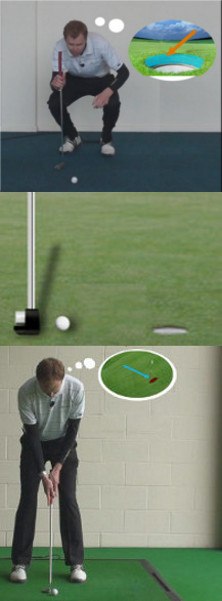
Process, Outcome, and the Short Game
We touched briefly on the topic of putting earlier, but this last section is going to dive deeper into the short game as a whole. Just as is the case on the rest of the course, it is also easy to base your short game analysis on outcomes instead of the process you use. The hole is right there in front of you, so the outcome-based analysis is extremely easy – and tempting. If the ball misses, you made a mistake. If it falls in, you did your job. Of course, looking at things that way is misleading, and it could cause you to make changes in your technique when none need to be made.
First, let's talk quickly again about putting. You are never going to make all of your putts, even when putting from short range. In fact, a robot would not make all of its putts, either. There are too many variables between your ball and the hole to count on getting a great roll every time. Greens speeds can change from hole to hole, your ball can hit something on the green like a ball mark or a small pebble, or the ball can wobble due to grain in the grass. Whatever the case, you can't always blame yourself when a putt goes awry.
At the same time, you shouldn't always blame the greens when you miss a putt, either. Sometimes, a missed putt is going to be your fault, and you need to recognize that in order to make corrections. To properly identify when you have done your job and when you have made a mistake, you need to pay attention to the feel of the stroke. Did you contact the ball on the sweet spot? Did you keep your head down through impact? Trust your feel and only make changes to your stroke when you are confident that something is wrong.
Moving back off the green, there are even more variables to consider when chipping. It is possible to strike a great chip and have the ball finish nowhere near the hole – and it is also possible to hit a terrible chip which falls in the cup. Again here, you need to pay attention to things like the quality of the strike and your ability to hit your landing spot. If you get a bad bounce or you have to play from a bad lie, that shouldn't affect the way you view your own performance. Chipping is one of the biggest challenges on the course for amateur golfers, so it is particularly important in this area that you pay attention to the things you can control. Work on the fundamentals of your technique, work on your ability to control distance, and let everything else go. There will be good and bad shots along the way, but your dedication to the process will show up in the end.
As far as golf instruction goes, thinking about process vs. outcome is a little bit outside of the mainstream tips you will find on the web. However, this is an important concept to think about in your game, as it can help you to focus on the areas of your performance which actually need the most work. Don't waste any more time working on things that aren't actually a problem – zero in on your real weaknesses through process-based analysis and improve from there. Good luck!






